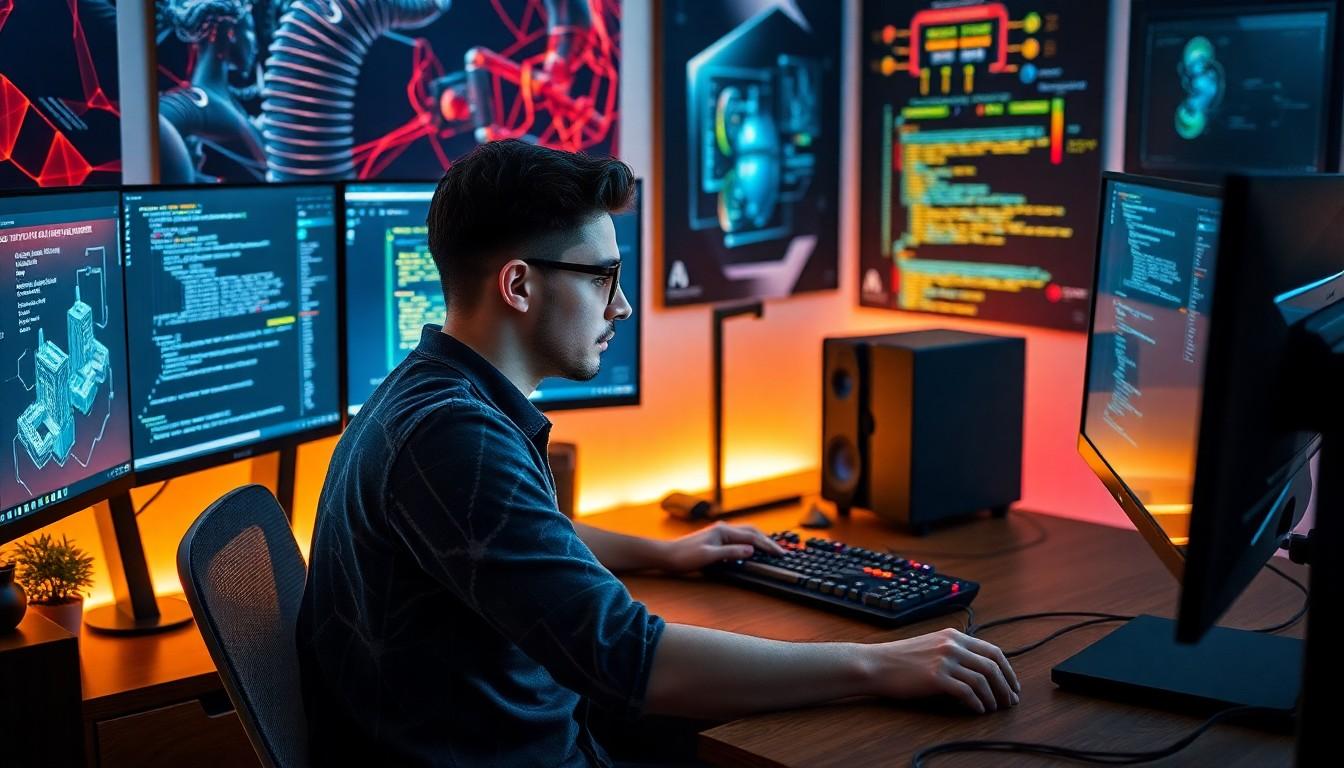Key Takeaways
- Essential Role: Graphics programming is crucial for creating immersive visual experiences in video games, virtual reality, and simulations, blending artistry with technical expertise.
- Key Techniques: Mastering rendering techniques (like rasterization and ray tracing), coordinate systems, and shading models is vital for producing high-quality graphics.
- Programming Languages: Familiarity with languages such as C++, C#, and tools like Unity and Unreal Engine is essential for effective graphics programming and development.
- Performance Optimization: Techniques such as level of detail (LOD) and efficient memory management are critical for ensuring smooth rendering and responsive applications.
- Emerging Trends: The future of graphics programming will be shaped by advancements in ray tracing, machine learning, cloud-based rendering, and developments in virtual and augmented reality.
- Cross-Platform Development: A growing demand for cross-platform compatibility necessitates skilled graphics programmers who can create engaging content across various devices.
Graphics programming is the backbone of modern visual experiences, shaping everything from video games to virtual reality. As technology advances, the demand for stunning graphics and immersive environments has skyrocketed, pushing developers to master complex techniques and tools. This field combines artistry and technical skill, allowing creators to bring their visions to life in ways that captivate audiences.
With a variety of programming languages and frameworks available, graphics programming offers endless possibilities. Whether it’s creating realistic 3D models or developing intricate animations, understanding the fundamentals is crucial for anyone looking to thrive in this dynamic industry. As the lines between reality and digital worlds blur, the role of graphics programming becomes more vital than ever.
Graphics Programming
Graphics programming encompasses techniques and practices for developing visual content in digital environments. It serves various applications, including video games, simulations, virtual reality, and user interfaces. Graphics programmers create algorithms and use programming languages to render images, manage visual data, and optimize performance.
Developers utilize multiple frameworks and libraries designed for graphics programming. Popular choices include OpenGL, DirectX, and Vulkan. Each framework offers unique features and capabilities, catering to specific project requirements. Understanding these frameworks enables developers to manipulate computer graphics efficiently.
Graphics programming relies on mathematical concepts and principles, particularly linear algebra, geometry, and trigonometry. These topics facilitate transformations, shading, and lighting calculations critical for achieving realistic visuals. Mastery of these concepts enhances a developer’s ability to create sophisticated graphics.
Performance optimization stands as a crucial aspect of graphics programming. Techniques such as level of detail (LOD), texture compression, and efficient memory management contribute to smoother rendering and reduced latency. Developers analyze performance metrics to fine-tune applications for optimal user experiences.
Emerging technologies shape the future of graphics programming. Advancements in hardware capabilities, such as ray tracing and machine learning, expand graphical possibilities. As graphics programming evolves, developers must adapt to new tools and techniques to stay competitive in the industry.
Key Concepts In Graphics Programming

Key concepts in graphics programming lay the groundwork for creating compelling visual content. Understanding rendering techniques, coordinate systems, and shading models enhances the ability to produce high-quality graphics.
Rendering Techniques
Rendering techniques define how images are generated from 3D models. Common methods include rasterization and ray tracing.
- Rasterization converts 3D models into 2D images by projecting their vertices onto the screen, prioritizing speed and efficiency.
- Ray tracing simulates light rays to create photorealistic images, accounting for reflections, refractions, and shadows, but demands significant computational resources.
- Deferred shading separates geometry rendering from lighting calculation, improving performance for scenes with complex lighting.
Each technique offers unique advantages, depending on the requirements of the project, and understanding them is vital for effective graphics programming.
Coordinate Systems
Coordinate systems provide the framework for positioning objects in 3D space. Key coordinate systems include:
- World Coordinate System establishes a global reference for all objects in the scene.
- Camera Coordinate System defines the perspective from which the scene is viewed, crucial for visual fidelity.
- Object Coordinate System relates specifically to individual objects and their local transformations.
Knowing how to manipulate these systems allows developers to control object placement and camera movement, facilitating immersive experiences.
Shading Models
Shading models determine how light interacts with surfaces, creating the appearance of depth and texture. Common shading models include:
- Phong Shading uses an empirical approach to simulate shiny surfaces by incorporating specular highlights.
- Blinn-Phong Shading refines Phong Shading by improving performance in rendering smooth surfaces.
- Physically Based Rendering (PBR) simulates light based on physical laws, enabling more accurate and consistent interactions between light and materials.
Each shading model plays a critical role in achieving realistic visuals and enhances the overall quality of graphics programming.
Graphics Programming Languages And Tools
Graphics programming relies on various languages and tools that facilitate the creation of stunning visual experiences. Understanding these languages and environments is crucial for developers aiming to excel in this field.
Popular Programming Languages
- C++: C++ is widely used in graphics programming due to its performance and flexibility. It allows for the manipulation of hardware-level graphics, making it a favorite for game engines and applications requiring high-speed rendering.
- C#: C# is popular in Unity development, providing a user-friendly syntax. It simplifies scriptwriting for game mechanics and graphics, attracting indie developers and large studios alike.
- Python: Python, with libraries like Pygame and PyOpenGL, offers ease of use for beginners. Its simplicity and extensive libraries support quick prototyping and learning.
- JavaScript: JavaScript, in conjunction with WebGL, enables graphics programming in web browsers. It’s essential for creating interactive web applications and games.
- GLSL: OpenGL Shading Language (GLSL) specializes in writing shaders. It provides developers with control over graphics rendering, enabling advanced effects and optimizations.
- HLSL: High-Level Shading Language (HLSL) works with DirectX. It allows for detailed shader development, crucial for high fidelity in real-time graphics applications.
Development Environments
- Unity: Unity is a versatile game engine offering an integrated development environment. Its support for both 2D and 3D graphics makes it suitable for diverse game projects.
- Unreal Engine: Unreal Engine is renowned for its high-quality graphics capabilities. It features Blueprints, a visual scripting language, that allows developers to design complex interactions without extensive coding.
- OpenGL: OpenGL is a cross-platform API for rendering 2D and 3D vector graphics. Its extensive toolset enables developers to manage graphics rendering effectively across different platforms.
- DirectX: DirectX, primarily for Windows applications, provides tools for designing high-performance games. It includes Direct3D, essential for rendering 3D graphics.
- Blender: Blender is an open-source 3D graphics software that supports modeling, rendering, animation, and more. It’s valuable for both amateur and professional developers looking for a comprehensive toolset.
- Visual Studio: Visual Studio offers robust support for C++ and C# development. It features powerful debugging tools and an intuitive interface, streamlining the graphics programming process.
Applications Of Graphics Programming
Graphics programming plays a pivotal role across various sectors, driving the development of visually engaging applications. This discipline enhances user experiences by creating intricate visual content tailored for specific industries.
Video Games
Video games exemplify the dynamic use of graphics programming. Developers leverage powerful graphics APIs like DirectX and OpenGL to render immersive environments and lifelike characters. Techniques such as real-time rendering, particle systems, and level of detail (LOD) optimization contribute to the visual fidelity and responsiveness of gameplay. Artificial intelligence (AI) integration further enhances realism, creating dynamic interactions between players and game elements. Effective implementation of shaders and lighting models enriches the visual landscape, providing players with an engaging and immersive experience.
Simulation And Visualization
Graphics programming is crucial in simulation and visualization applications, including scientific research, medical training, and architectural design. Realistic renderings facilitate the analysis of complex data sets, enabling professionals to visualize outcomes and make informed decisions. Tools such as Unity and Unreal Engine support the development of simulations that mimic real-world phenomena, aiding in training and education. Advanced techniques, such as volumetric rendering and fluid simulations, produce high-quality visualizations that enhance understanding and engagement in various fields.
Future Trends In Graphics Programming
Graphics programming is poised for transformative advancements driven by several emerging trends.
Increasing Use of Ray Tracing
Ray tracing continues to gain traction in real-time applications. This technique simulates the behavior of light, resulting in stunningly realistic visuals. With advancements in hardware acceleration, real-time ray tracing becomes more accessible, enhancing the visual fidelity of video games and simulations.
Integration of Machine Learning
Machine learning significantly influences graphics programming. Algorithms optimize rendering processes, improve texture generation, and enhance visual effects. Neural networks assist in upscaling images, resulting in high-quality outputs with reduced computational costs. Developers embrace these tools to create more immersive experiences.
Cloud-Based Rendering
Cloud-based rendering is transforming how graphics are produced. This approach allows heavy computations to occur on powerful remote servers, freeing local resources. Users experience high-quality graphics regardless of device capabilities, promoting accessibility across various platforms and devices.
Virtual and Augmented Reality
Virtual reality (VR) and augmented reality (AR) continue to expand. Graphics programming adapts to these environments by offering more realistic interactions and environments. Development in this space requires nuanced understanding of user experience to create seamless integrations that engage users.
Procedural Content Generation
Procedural content generation enables the creation of vast, detailed environments with minimal manual effort. Algorithms generate landscapes, textures, and models dynamically, providing unique experiences. This method of graphics programming not only saves time but also allows for infinite variations.
Enhanced Realism through Physically Based Rendering
Physically Based Rendering (PBR) techniques improve how materials respond to light. More accurate representations of surfaces impact lighting, shading, and texture quality. Developers are increasingly adopting PBR workflows to ensure consistent and realistic results across platforms.
Cross-Platform Development
Cross-platform development is growing, requiring graphics programmers to create compatible content for various systems. Tools and frameworks allow developers to deploy graphics seamlessly across devices, including consoles, PCs, and mobile phones, ensuring a broader audience reach.
These trends highlight an evolving landscape in graphics programming, shaping future visual experiences and setting new standards for quality and engagement.
Graphics Programming
Graphics programming stands at the forefront of modern visual experiences. As technology advances the demand for immersive environments grows. Developers must continually adapt to new tools and techniques to create stunning visuals that engage users across various applications.
Mastering the fundamentals of graphics programming is crucial for success in this dynamic field. With emerging trends like ray tracing and machine learning, the landscape is evolving rapidly. Those who embrace these changes will not only enhance their skills but also contribute to the future of digital artistry.
The intersection of creativity and technical expertise in graphics programming opens doors to endless possibilities. By leveraging the right languages and frameworks, developers can bring their visions to life, enriching user experiences in ways previously unimaginable.
